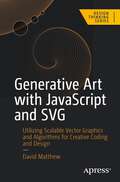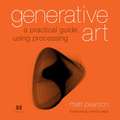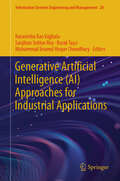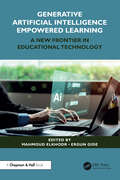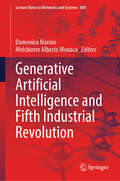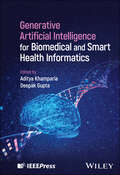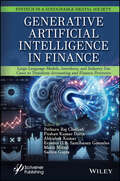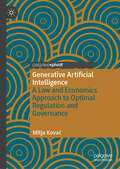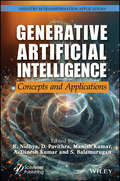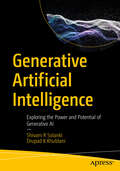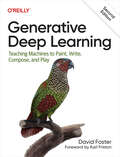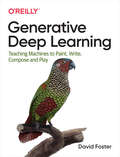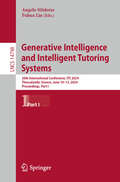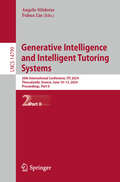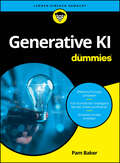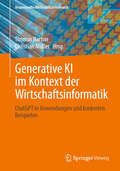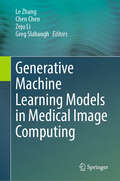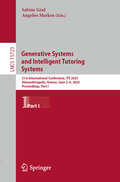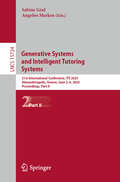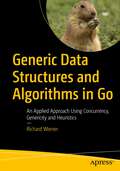- Table View
- List View
Generative Art with JavaScript and SVG: Utilizing Scalable Vector Graphics and Algorithms for Creative Coding and Design (Design Thinking)
by David MatthewThis book introduces you to the exciting world of generative art and creative coding through the medium of JavaScript and Scalable Vector Graphics (SVG). Using tried and trusted techniques, you’ll tackle core topics such as randomness and regularity, noise and naturalistic variance, shape and path creation, filter effects, animation, and interactivity. In the process you’ll learn SvJs, a JavaScript library that closely mirrors the SVG spec and makes scripting SVG intuitive and enjoyable. You’ll also study the craft of generative art and its creative process, along with JavaScript fundamentals, using modern ES6+ syntax. Each chapter will build upon the previous one, and those completely new to programming will be given a primer to help them find their feet. Generative Art with JavaScript and SVG will take you on a fun journey, peppered with plenty of sketches throughout, designed not only to explain, but to inspire. You Will: • Structure and randomise compositions. • Understand the different types of randomness and their probability distributions. • Create organic variance with the SvJs Noise module. • Apply SVG filter effects in a generative fashion. • Explore different approaches to animating with SVG. • Make your compositions dynamic and interactive. WHO IS IT FOR: Web developers and designers and creative coders with an interest in digital and generative art as well as artists who are interested in learning to code with JavaScript.
Generative Art: A practical guide using Processing
by Matt PearsonSummaryGenerative Art presents both the technique and the beauty of algorithmic art. The book includes high-quality examples of generative art, along with the specific programmatic steps author and artist Matt Pearson followed to create each unique piece using the Processing programming language.About the TechnologyArtists have always explored new media, and computer-based artists are no exception. Generative art, a technique where the artist creates print or onscreen images by using computer algorithms, finds the artistic intersection of programming, computer graphics, and individual expression. The book includes a tutorial on Processing, an open source programming language and environment for people who want to create images, animations, and interactions.About the BookGenerative Art presents both the techniques and the beauty of algorithmic art. In it, you'll find dozens of high-quality examples of generative art, along with the specific steps the author followed to create each unique piece using the Processing programming language. The book includes concise tutorials for each of the technical components required to create the book's images, and it offers countless suggestions for how you can combine and reuse the various techniques to create your own works. Purchase of the print book comes with an offer of a free PDF, ePub, and Kindle eBook from Manning. Also available is all code from the book. What's InsideThe principles of algorithmic artA Processing language tutorialUsing organic, pseudo-random, emergent, and fractal processes=================================================Table of ContentsPart 1 Creative CodingGenerative Art: In Theory and PracticeProcessing: A Programming Language for ArtistsPart 2 Randomness and NoiseThe Wrong Way to Draw A LineThe Wrong Way to Draw a CircleAdding DimensionsPart 3 ComplexityEmergenceAutonomyFractals
Generative Artificial Intelligence (Information Systems Engineering and Management #24)
by Sanjiban Sekhar Roy Narasimha Rao Vajjhala Burak Taşcı Muhammad Enamul Hoque Chowdhury"Generative Artificial Intelligence (AI) Approaches for Industrial Applications" explores the transformative potential of Generative AI technologies across various industries. With contributions from international scholars and experts, this book provides a comprehensive overview of the latest trends, mathematical foundations, and practical applications of Generative AI models. Key sections examine the fundamental concepts of Generative AI, including Generative Adversarial Networks (GANs) and their ethical and security considerations. Special attention is given to the revolutionary impact of Generative AI in healthcare technologies, clinical decision-making, and predictive maintenance within the manufacturing sector. Additionally, the role of Generative AI in FinTech, particularly in redefining business models and enhancing digital security, is thoroughly examined. This book features cutting-edge research on text summarization, age progression using GANs, and integrating AI with regulatory practices. This book is a vital resource for academics, professionals, and practitioners bridging the gap between theoretical AI frameworks and their real-world industrial applications, offering insights into how Generative AI is shaping the future of industries worldwide.
Generative Artificial Intelligence Empowered Learning: A New Frontier in Educational Technology
by Mahmoud Elkhodr Ergun GideThis book explores the integration of Generative Artificial Intelligence (GenAI), such as ChatGPT, into educational practices and research methodologies. With the potential to transform traditional learning environments, this book addresses both the opportunities and challenges that come with leveraging GenAI for enhancing teaching and learning experiences.This comprehensive guide delves into multiple aspects of GenAI in education. It covers critical topics such as project-based learning (PBL), personalized learning through AI, AI-driven student assessment, and the role of AI in special education. Furthermore, it examines ethical considerations, the readiness of students and teachers for AI technologies, and case studies on AI’s impact on student outcomes. With insights from educators, researchers, and practitioners from around the globe, the book provides a balanced perspective on both theoretical frameworks and practical implementation of GenAI technologies.Ideal for educators, researchers, and policymakers, this book serves as a practical resource for those looking to effectively integrate AI into their pedagogical and research efforts. It is an essential reference for anyone interested in staying at the forefront of educational innovation and exploring the future possibilities of AI-empowered learning.
Generative Artificial Intelligence and Fifth Industrial Revolution (Lecture Notes in Networks and Systems #880)
by Domenico Marino Melchiorre Alberto MonacaIn this digital era, artificial intelligence (AI) is emerging as a catalyst for transformation across numerous fields, ranging from, economics, environment, finance to healthcare, AI's integration into daily operations and strategic planning presents a pivotal shift towards data-driven decision-making and automation. Each chapter in this volume addresses a unique aspect of AI, from theoretical frameworks and technological advancements to practical applications and ethical considerations. This volume not only highlights the advancements and applications of AI but also addresses the critical challenges of bias, privacy, and ethical implications associated with AI deployment. Through a multidisciplinary approach, it aims to provide readers with a nuanced understanding of AI's role in modern society and its potential to address some of the most pressing challenges of our times. As we stand on the brink of technological revolutions, this volume serves as a guide and a critical examination of the potential pathways AI might forge in the future. It is an essential read for academics, industry professionals, policymakers, and anyone interested in the profound changes AI is poised to bring. This is a multi-author book, but not a collection of essays. In fact, although signed by different authors, all the chapters of the book follow a line of development which is traced in the first part of the book and deepen the various aspects in logical order. The various parts of the book will explore the most important features of AI and analyse the implications of AI in Economics, Law, Policies, Smart Citizens and Territorial Aspects.
Generative Artificial Intelligence for Biomedical and Smart Health Informatics
by Deepak Gupta Aditya KhampariaEnables readers to understand the future of medical applications with generative AI and related applications Generative Artificial Intelligence for Biomedical and Smart Health Informatics delivers a comprehensive overview of the most recent generative AI-driven medical applications based on deep learning and machine learning in which biomedical data is gathered, processed, and analyzed using data augmentation techniques. This book covers many applications of generative models for medical image data, including volumetric medical image segmentation, data augmentation, MRI reconstruction, and modeling of spatiotemporal medical data. The book explores findings obtained by explainable AI techniques, with coverage of various techniques rarely reported in literature. Throughout, feedback and user experiences from physicians and medical staff, as well as use cases, are included to provide important context. The book discusses topics including privacy and security challenges in AI-enabled health informatics, biosensor-guided AI interventions in personalized medicine, regulatory frameworks and guidelines for AI-based medical devices, education and training for building responsible AI solutions in healthcare, and challenges and opportunities in integrating generative AI with wearable devices. Topics covered include: Treatment of neurological disorders using intelligent techniques and image-guided and tomography interventions for neuromuscular disordersBio-inspired smart healthcare service frameworks with AI, machine learning, and deep learning, integration of IoT devices, and edge computing in industrial and clinical systemsTraffic management and optimization in distributed environments, patient data management, disease surveillance and prediction, and telemedicine and remote monitoringEducation-driven, peer-to-peer, and service-oriented architectures and transparency and accountability in medical decision-making Generative Artificial Intelligence for Biomedical and Smart Health Informatics is an essential reference for computer science researchers, medical professionals, healthcare informatics, and medical imaging researchers interested in understanding the potential of artificial intelligence and other related technologies in healthcare.
Generative Artificial Intelligence in Finance: Large Language Models, Interfaces, and Industry Use Cases to Transform Accounting and Finance Processes (Fintech in a Sustainable Digital Society)
by Abhishek Kumar Pethuru Raj Chelliah Mohit Mittal Sachin Gupta Pushan Kumar Dutta Ernesto D.R. Santibanez GonzalezThis comprehensive volume delves deep into the diverse applications and implications of generative AI across accounting, finance, economics, business, and management, providing readers with a holistic understanding of this rapidly evolving landscape. Generative Artificial Intelligence in Finance: Large Language Models, Interfaces, and Industry Use Cases to Transform Accounting and Finance Processes provides a comprehensive guide to ethically harnessing generative AI systems to reshape financial management. Generative AI is a key theme across the accounting and finance sectors to drive significant optimizations leading to sustainability. Across 22 chapters, leading researchers supply innovative applications of large language models across the economic realm. Through detailed frameworks, real-world case studies, and governance recommendations, this book highlights applied research for generative AI in finance functions. Several chapters demonstrate how data-driven insights from AI systems can optimize complex financial processes to reduce resource usage, lower costs, and drive positive environmental impact over the long term. In addition, chapters on AI-enabled risk assessment, fraud analytics, and regulatory technology highlight applied research for generative AI in finance. The book also explores emerging applications like leveraging blockchain and metaverse interfaces to create generative AI models that can revolutionize areas from carbon credit trading to virtual audits. Overall, with in-depth applied research at the nexus of sustainability and optimization enabled by data science and generative AI, the book offers a compilation of best practices in leveraging AI for optimal, ethical, and future-oriented financial management. Audience The audience for this book is quite diverse, ranging from financial and accounting experts across banking, insurance, consultancies, regulatory agencies, and corporations seeking to enhance productivity and efficiency; business leaders want to implement ethical and compliant AI practices; researchers exploring the domain of AI and finance.
Generative Artificial Intelligence: A Law and Economics Approach to Optimal Regulation and Governance
by Mitja KovačThis book takes a comparative law and economics approach to explore the role of public and private actors in regulating generative artificial intelligence. The book provides an introduction and context for the creation of new generative AI technologies, now understood to be the chief goal of the leading AI companies. As autonomous ‘super-intelligences’, these technologies are still an unknown entity which nevertheless have profound implications for liberal democracy, consumer choice mechanisms, mutual trust, and political legitimacy. This book explores the deep challenges posed for lawmakers and how we can achieve an optimal form of regulation and governance of such unreliable technologies. Chapters investigate possible hybrid modes of regulation, such as a co-regulatory approach between private AI companies and public actors in addressing the issue of misinformation spread. It also explores mixed types of regulation toward research on new forms of AI, arguing that different levels of systemic risk posed by different technologies must be accounted for. Different contemporary and historical contexts for the regulation of unprecedented technical innovation are also considered, and new suggestions for policy are presented. This book is a timely resource which will be of interest to researchers and practitioners in economic governance, law and regulation, artificial intelligence, and comparative law.
Generative Artificial Intelligence: Concepts and Applications (Industry 5.0 Transformation Applications)
by Manish Kumar S. Balamurugan R. Nidhya D. Pavithra A. Dinesh KumarThis book is a comprehensive overview of AI fundamentals and applications to drive creativity, innovation, and industry transformation. Generative AI stands at the forefront of artificial intelligence innovation, redefining the capabilities of machines to create, imagine, and innovate. GAI explores the domain of creative production with new and original content across various forms, including images, text, music, and more. In essence, generative AI stands as evidence of the boundless potential of artificial intelligence, transforming industries, sparking creativity, and challenging conventional paradigms. It represents not just a technological advancement but a catalyst for reimagining how machines and humans collaborate, innovate, and shape the future. The book examines real-world examples of how generative AI is being used in a variety of industries. The first section explores the fundamental concepts and ethical considerations of generative AI. In addition, the section also introduces machine learning algorithms and natural language processing. The second section introduces novel neural network designs and convolutional neural networks, providing dependable and precise methods. The third section explores the latest learning-based methodologies to help researchers and farmers choose optimal algorithms for specific crop and hardware needs. Furthermore, this section evaluates significant advancements in revolutionizing online content analysis, offering real-time insights into content creation for more interactive processes. Audience The book will be read by researchers, engineers, and students working in artificial intelligence, computer science, and electronics and communication engineering as well as industry application areas.
Generative Artificial Intelligence: Exploring the Power and Potential of Generative AI
by Shivam R Solanki Drupad K KhublaniThis book explains the field of Generative Artificial Intelligence (AI), focusing on its potential and applications, and aims to provide you with an understanding of the underlying principles, techniques, and practical use cases of Generative AI models. The book begins with an introduction to the foundations of Generative AI, including an overview of the field, its evolution, and its significance in today’s AI landscape. It focuses on generative visual models, exploring the exciting field of transforming text into images and videos. A chapter covering text-to-video generation provides insights into synthesizing videos from textual descriptions, opening up new possibilities for creative content generation. A chapter covers generative audio models and prompt-to-audio synthesis using Text-to-Speech (TTS) techniques. Then the book switch gears to dive into generative text models, exploring the concepts of Large Language Models (LLMs), natural language generation (NLG), fine-tuning, prompt tuning, and reinforcement learning. The book explores techniques for fixing LLMs and making them grounded and indestructible, along with practical applications in enterprise-grade applications such as question answering, summarization, and knowledge-based generation. By the end of this book, you will understand Generative text, and audio and visual models, and have the knowledge and tools necessary to harness the creative and transformative capabilities of Generative AI. What You Will Learn What is Generative Artificial Intelligence? What are text-to-image synthesis techniques and conditional image generation? What is prompt-to-audio synthesis using Text-to-Speech (TTS) techniques? What are text-to-video models and how do you tune them? What are large language models, and how do you tune them? Who This Book Is For Those with intermediate to advanced technical knowledge in artificial intelligence and machine learning
Generative Deep Learning: Teaching Machines To Paint, Write, Compose, and Play
by David FosterGenerative AI is the hottest topic in tech. This practical book teaches machine learning engineers and data scientists how to use TensorFlow and Keras to create impressive generative deep learning models from scratch, including variational autoencoders (VAEs), generative adversarial networks (GANs), Transformers, normalizing flows, energy-based models, and denoising diffusion models.The book starts with the basics of deep learning and progresses to cutting-edge architectures. Through tips and tricks, you'll understand how to make your models learn more efficiently and become more creative.Discover how VAEs can change facial expressions in photosTrain GANs to generate images based on your own datasetBuild diffusion models to produce new varieties of flowersTrain your own GPT for text generationLearn how large language models like ChatGPT are trainedExplore state-of-the-art architectures such as StyleGAN2 and ViT-VQGANCompose polyphonic music using Transformers and MuseGANUnderstand how generative world models can solve reinforcement learning tasksDive into multimodal models such as DALL.E 2, Imagen, and Stable DiffusionThis book also explores the future of generative AI and how individuals and companies can proactively begin to leverage this remarkable new technology to create competitive advantage.
Generative Deep Learning: Teaching Machines to Paint, Write, Compose, and Play
by David FosterGenerative modeling is one of the hottest topics in AI. It’s now possible to teach a machine to excel at human endeavors such as painting, writing, and composing music. With this practical book, machine-learning engineers and data scientists will discover how to re-create some of the most impressive examples of generative deep learning models, such as variational autoencoders, generative adversarial networks (GANs), encoder-decoder models and world models.Author David Foster demonstrates the inner workings of each technique, starting with the basics of deep learning before advancing to some of the most cutting-edge algorithms in the field. Through tips and tricks, you’ll understand how to make your models learn more efficiently and become more creative. Discover how variational autoencoders can change facial expressions in photos; Build practical GAN examples from scratch, including CycleGAN for style transfer and MuseGAN for music generation; Create recurrent generative models for text generation and learn how to improve the models using attention; Understand how generative models can help agents to accomplish tasks within a reinforcement learning setting; Explore the architecture of the Transformer (BERT, GPT-2) and image generation models such as ProGAN and StyleGAN.
Generative Intelligence and Intelligent Tutoring Systems: 20th International Conference, ITS 2024, Thessaloniki, Greece, June 10–13, 2024, Proceedings, Part I (Lecture Notes in Computer Science #14798)
by Angelo Sifaleras Fuhua LinThis book constitutes the refereed proceedings of the 20th International Conference on Generative Intelligence and Intelligent Tutoring Systems, ITS 2024, held in Thessaloniki, Greece, during June 10–13, 2024. The 35 full papers and 28 short papers included in this book were carefully reviewed and selected from 88 submissions. This book also contains 2 invited talks. They were organized in topical sections as follows: Generative Intelligence and Tutoring Systems; Generative Intelligence and Healthcare Informatics; Human Interaction, Games and Virtual Reality; Neural Networks and Data Mining; Generative Intelligence and Metaverse; Security, Privacy and Ethics in Generative Intelligence; and Generative Intelligence for Applied Natural Language Processing.
Generative Intelligence and Intelligent Tutoring Systems: 20th International Conference, ITS 2024, Thessaloniki, Greece, June 10–13, 2024, Proceedings, Part II (Lecture Notes in Computer Science #14799)
by Angelo Sifaleras Fuhua LinThis book constitutes the refereed proceedings of the 20th International Conference on Generative Intelligence and Intelligent Tutoring Systems, ITS 2024, held in Thessaloniki, Greece, during June 10–13, 2024. The 35 full papers and 28 short papers included in this book were carefully reviewed and selected from 88 submissions. This book also contains 2 invited talks. They were organized in topical sections as follows: Generative Intelligence and Tutoring Systems; Generative Intelligence and Healthcare Informatics; Human Interaction, Games and Virtual Reality; Neural Networks and Data Mining; Generative Intelligence and Metaverse; Security, Privacy and Ethics in Generative Intelligence; and Generative Intelligence for Applied Natural Language Processing.
Generative KI als neues Teammitglied im Marketing: Ein Leitfaden für Marketingmanger:innen (essentials)
by Bernhard WeckeGenerative Künstliche Intelligenz bringt die digitale Transformation im Marketing auf eine neue Ebene und stellt Marketingverantwortliche vor unbekannte Herausforderungen. Erfahren Sie, wie sich die Rolle von Marketingmanager:innen in Zeiten von Generativer KI verändert und welche neuen Kompetenzen gefragt sind. Darüber hinaus gibt das Buch einen Überblick über die Auswirkungen von Generativer KI auf Marketingorganisationen und einen konkreten Leitfaden zu den Handlungsfeldern. .
Generative KI für Dummies (Für Dummies)
by Pam BakerDie Möglichkeiten generativer KI optimal nutzen Mithilfe von generativer Künstlicher Intelligenz lassen sich Texte, Bilder, Videos, Sprache, Musik, Softwarecodes und auch Kunst und Design erschaffen. Doch wie können Sie die Möglichkeiten generativer KI individuell am besten nutzen? KI-Expertin Pam Baker gibt Ihnen einen guten Überblick und führt Sie in die bekanntesten Tools ein. Das Buch erklärt Ihnen, wie Sie geeignete Plattformen finden, gute Prompts schreiben, KI in Ihren Workflow einbinden und gezielt einsetzen – und entscheiden, wann doch ein wenig Human Touch gebraucht wird. Gut verständlich und praxisnah: der ideale Einstieg in ein Thema, das unsere Arbeitswelt rasant verändert. Sie erfahren Welche Plattformen sich für welche Zwecke eignen Wie Sie KI-generierte Texte, Bilder, Videos und Audios erstellen Wie Sie KI in Ihren Workflow integrieren Wie es Ihnen gelingt, KI-Inhalte »menschlicher« zu machen
Generative KI im Kontext der Wirtschaftsinformatik: ChatGPT in Anwendungen und konkreten Beispielen (Angewandte Wirtschaftsinformatik)
by Thomas Barton Christian MüllerGenerative KI stellt eine neue wichtige Technologie dar, die in der Lage ist, betriebliche Prozesse und Anwendungen zu automatisieren und zu optimieren. Inwieweit sich Generative KI wie ChatGPT für den Einsatz im Kontext der Wirtschaftsinformatik eignet, wird im Rahmen dieses Herausgeber-Bandes thematisiert. Dazu untersuchen einige Autoren-Teams den Einsatz von ChatGPT anhand verschiedener Beispiele. Die Beispiele umfassen sowohl Fragestellungen zum Lernen an der Hochschule wie zum Beispiel zur Texterstellung und zur Mathematik als auch zum betrieblichen Einsatz in der unternehmerischen Praxis in verschiedenen betriebswirtschaftlichen Anwendungsfeldern. Das Buch bietet wichtige Informationen, die für Praktiker ebenso relevant sind wie für Studierende und Lehrende.
Generative Künstliche Intelligenz in Marketing und Sales: Innovative Unternehmenspraxis: Insights, Strategien und Impulse
by Gabriele Schuster Thomas BolzDieses Buch beleuchtet die neuesten Entwicklungen in der Generativen KI und zeigt auf, wie Marketing und Vertrieb sie für sich nutzen können. KI verändert nicht nur einzelne Werkzeuge und Arbeitsweisen, sondern leitet einen grundlegenden Paradigmenwechsel in beiden Bereichen ein. Die Autor:innen bieten in ihren Beiträgen einen fundierten und umfassenden Einblick in aktuelle Anwendungsbereiche und Forschungsansätze zu Generativer KI im Marketing und Vertrieb. Thematisiert werden zahlreiche erfolgskritische Handlungsfelder, u. a. datenschutzrechtliche Herausforderungen, Social-Media- und Content-Marketing mit KI, Chatbots in der Employee-Journey, hyperpersonalisierte B2C-Kommunikation, KI-generierte Produkt- und SEO-Texte, bis hin zu Generativer KI in der Marketingforschung und die Rolle von KI in Start-ups. Das Werk richtet sich sowohl an Praktiker:innen und Entscheidungsträger:innen als auch an Forschende sowie Studierende und trägt dazu bei, das Verständnis für dieses dynamische und vielversprechende Feld zu vertiefen. Mit Beiträgen von: Prof. Dr. Petra Beenken Luise-Sophie Bleckmann Prof. Dr. Benny Björn Briesemeister Prof. Dr. Marc Ebel Susanne Fittkau Caroline Grauel Prof. Dr. Maik Günther Doris Hanway Prof. Dr. Claudia Heß Heiko Holz Isabel Hörmann Prof Dr. rer. pol. Kurt Jeschke Prof. Dr. Tobias Kesting Prof. Dr. Sonja Klose Prof. Dr. Ralf Kneuper Prof. Dr. Ralf T. Kreutzer Prof. Dr. Nicolai Krüger Prof. Dr. Sibylle Kunz Prof. Dr. Visieu Lac Christina Lagodka Prof. Dr. Alexander Lawall Prof. Dr. Damian Leschik Prof. Dr. Vera Lenz-Kesekamp Prof. Dr. Nikolaj Lunze Prof. Dr. Jan-Paul Lüdtke Elisabeth L’ Orange Sebastian Mertens Manuel Muth Prof. Dr. Gerd Nufer Prof. Dr. Miriam O’Shea Ban Pahlawan Florian Perst Marc Peter Prof. Dr. Jan Pieper Lavinia Celina Rahmawati Prof. Dr. Katharina-Maria Rehfeld Marie Salkowski Prof. Dr. Philipp Schmid Annkristin Schürhaus Freddy Sikouonmeu Neal Wessling Prof. Dr. Klaus Wildhirt Prof. Dr. Atilla Wohllebe Cansu Rosa Yildirim Prof. Dr. Tanja Marlen Zweigle
Generative Machine Learning Models in Medical Image Computing
by Chen Chen Le Zhang Zeju Li Greg SlabaughGenerative Machine Learning Models in Medical Image Computing" provides a comprehensive exploration of generative modeling techniques tailored to the unique demands of medical imaging. This book presents an in-depth overview of cutting-edge generative models such as GANs, VAEs, and diffusion models, examining how they enable groundbreaking applications in medical image synthesis, reconstruction, and enhancement. Covering diverse imaging modalities like MRI, CT, and ultrasound, it illustrates how these models facilitate improvements in image quality, support data augmentation for scarce datasets, and create new avenues for predictive diagnostics. Beyond technical details, the book addresses critical challenges in deploying generative models for healthcare, including ethical concerns, interpretability, and clinical validation. With a strong focus on real-world applications, it includes case studies and implementation guidelines, guiding readers in translating theory into practice. By addressing model robustness, reproducibility, and clinical utility, this book is an essential resource for researchers, clinicians, and data scientists seeking to leverage generative models to enhance biomedical imaging and deliver impactful healthcare solutions. Combining technical rigor with practical insights, it offers a roadmap for integrating advanced generative approaches in the field of medical image computing.
Generative Systems and Intelligent Tutoring Systems: 21st International Conference, ITS 2025, Alexandroupolis, Greece, June 2–6, 2025, Proceedings, Part I (Lecture Notes in Computer Science #15723)
by Angelos Markos Sabine GrafThis book constitutes the refereed proceedings of the 21st International Conference on Intelligent Tutoring Systems, ITS 2025, held in Alexandroupolis, Greece, during June 2–6, 2025. The 21 full papers, 27 short papers and 5 posters included in this book were carefully reviewed and selected from 67 submissions. The papers are organized in the following topical conference tracks: Part I: Generative Tutoring Systems. The goal of this part is to show how new techniques inspired by artificial intelligence (AI) and new methods in education can improve learning, teaching, and generate the capacity for knowledge acquisition and much more. Part II: Application areas, environments, and techniques for AI systems. This part shows the progress of research investigating the different application areas (such as education, health), techniques (such as neural networks, data mining, natural language processing) and environments (such as games, virtual reality, cognitive robots) for effective AI systems.
Generative Systems and Intelligent Tutoring Systems: 21st International Conference, ITS 2025, Alexandroupolis, Greece, June 2–6, 2025, Proceedings, Part II (Lecture Notes in Computer Science #15724)
by Angelos Markos Sabine GrafThis book constitutes the refereed proceedings of the 21st International Conference on Intelligent Tutoring Systems, ITS 2025, held in Alexandroupolis, Greece, during June 2–6, 2025. The 21 full papers, 27 short papers and 5 posters included in this book were carefully reviewed and selected from 67 submissions. The papers are organized in the following topical conference tracks: Part I: Generative Tutoring Systems. The goal of this part is to show how new techniques inspired by artificial intelligence (AI) and new methods in education can improve learning, teaching, and generate the capacity for knowledge acquisition and much more. Part II: Application areas, environments, and techniques for AI systems. This part shows the progress of research investigating the different application areas (such as education, health), techniques (such as neural networks, data mining, natural language processing) and environments (such as games, virtual reality, cognitive robots) for effective AI systems.
Genere ingresos pasivos con quora: Y olvidese de su trabajo
by Marcus PfeifferEste libro trata sobre cómo ganar dinero bajo un sistema de recomendaciones de productos y servicios a través de la plataforma de quora, haciendo ingresos pasivos en línea.
Generic Data Structures and Algorithms in Go: An Applied Approach Using Concurrency, Genericity and Heuristics
by Richard WienerAdvance your understanding of generic data structures and algorithms and their applications using Go and the effective use of concurrency. You are invited on a journey that aims to improve your programming and problem-solving skills. This book takes you to the next step by showing how to get your programs to work efficiently as well as correctly. As you explore many data structures and the algorithms and applications associated with them, you'll focus on the trade-offs between speed and storage and the benefits of deploying concurrency when appropriate. This book will demonstrate the huge increases in application performance that are possible. The presentation of classic data structures and techniques of algorithm design (greedy, divide and conquer, branch-and-bound to name a few) provides an essential foundation and toolkit for problem solving. But this book goes further by presenting heuristic algorithms and their implementations for solving computationally intractable combinatoric optimization problems such as the travelling salesperson problem. Simulated annealing and genetic algorithms are among the techniques used.The consistent style of coding used throughout this book exploits Go’s ability to implement abstract, generic and constrained generic data types without the use of classes. Although some familiarity with Go is assumed, this book should advance your ability to use Go to tackle server-side applications, games, machine learning, information retrieval and other application domains where speed and storage efficiency is essential.What You'll LearnExplore classical data structures and algorithms aimed at making your applications run faster or require less storageUse the new generic features of Go to build reusable data structuresUtilize concurrency for maximizing application performanceSee the power of heuristic algorithms for computationally intractable problemsEnhance and improve your Go programming skillsWho This Book Is ForPracticing Go software developers and students who wish to advance their programming and problem-solving skills and experience the excitement and see the benefits of using generic data structures and algorithms that utilize concurrency whenever possible.
Generic Pipelines Using Docker: The DevOps Guide to Building Reusable, Platform Agnostic CI/CD Frameworks
by Brandon Atkinson Dallas EdwardsCreate generic pipelines to reduce your overall DevOps workload and allow your team to deliver faster. This book helps you get up to speed on the pros and cons of generic pipeline methodology, and learn to combine shell scripts and Docker to build generic pipelines.In today’s world of micro-services and agile practices, DevOps teams need to move as fast as feature teams. This can be extremely challenging if you’re creating multiple pipelines per application or tech stack. What if your feature teams could utilize a generic pipeline that could build, test, and deploy any application, regardless of tech stack? What if that pipeline was also cloud and platform agnostic? Too good to be true? Well think again! Generic Pipelines Using Docker explores the principles and implementations that allow you to do just that. You will learn from real-world examples and reusable code. After reading this book you will have the knowledge to build generic pipelines that any team can use. What You'll Learn Explore the pros and cons of generic pipeline methodologyCombine shell scripts and Docker to build a generic pipelineImplement a pipeline across CI/CD platformsBuild a pipeline that lends itself well to both centralized and federated DevOps teamsConstruct a modular pipeline with components that can be added, removed, or replaced as needed Who This Book Is ForProfessionals who use DevOps or are part of a DevOps team, and are seeking ways to streamline their pipelines and drive more deployments while using less code
Generic and Energy-Efficient Context-Aware Mobile Sensing
by Chi Harold Liu Ozgur YururElaborating on the concept of context awareness, this book presents up-to-date research and novel framework designs for context-aware mobile sensing. Generic and Energy-Efficient Context-Aware Mobile Sensing proposes novel context-inferring algorithms and generic framework designs that can help readers enhance existing tradeoffs in mobile sensing,
